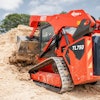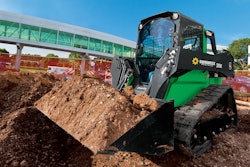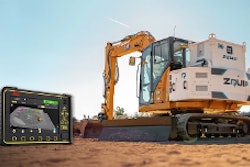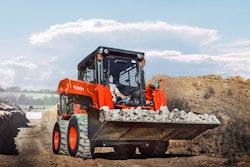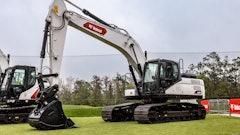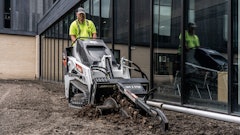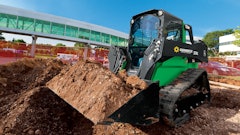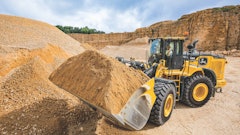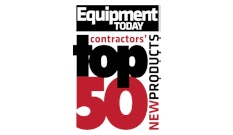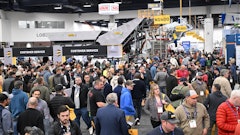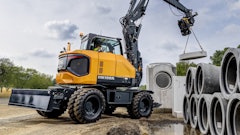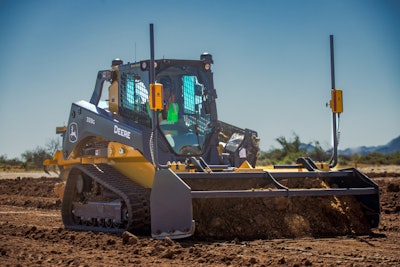
When I started in the industry more than 30 years ago, contractors would often opt for compact construction equipment (CCE) that had the lowest price point. Original equipment manufacturers (OEMs) developed CCE mostly focused on its ability to function, not thinking about comfort or technology. Then, during the 2000s, OEMs recognized the need to address labor challenges in our industry. CCE machines not only needed to be durable but also increased their user-friendly controls and in-the-cab comfort. The industry today understands machine comfort and ease of use are key factors in operator fatigue, a concept gaining ever more attention as it pertains to safe and consistent jobsites
Today, these power-packed yet compact machines are found at almost every jobsite I visit. Manufacturers like John Deere offer equipment tiers, so contractors can choose the tier that fits their projects, jobsites and desired attachments or technology solutions.
Compact Construction Equipment Tiers Explained
At CONEXPO 2020, John Deere introduced its tiering performance system through three letters — G, P or X — to quickly identify economy, advanced or hybrid diesel-electric technology machines. The company developed its G and P-Tiers based on feedback from its Customer Advocacy Group, including customers and trusted dealers.
Designed for versatility, the G-Tier machinery — including compact track loaders (CTLs) and compact wheel loaders — created the most value for money, as operators said these machines quickly completed tasks. The P-Tier machinery — including CTLs and skid steer loaders — impressed operators through demos when they experienced these machines’ horsepower and options for attachments and machine control, like SmartGrade. (John Deere’s X-Tier machines includes its E-Power battery-hybrid engines in the 244X Compact Wheel Loader or 310X Backhoe. These X-Tier machines come with the most high) While the G and P-Tier compact machines appear the most similar, each tier’s features vary slightly, affecting their performance.
G-Tier: Rugged and Reliable Machines, Automate Data Collection
In the simplest sense, John Deere’s G-Tier includes midsize machines designed for maneuverability and versatility. During the mid-2010s, construction equipment costs slowly increased after the EPA required most machines to adhere to the final Tier 4 engine emissions regulations which motivated OEMs to develop machines that can increase an operator’s productivity and maximize uptime on many different jobsites.
Landscapers, municipal workers or operators offering specific rental or subcontracting services favored the G-Tier machines’ maneuverability and ability to navigate varying terrains or urban areas. Built with a smaller width and weight for contained jobsite areas, the 320G and 324G skid steers and the 325G CTL can travel terrain with less ground disturbance than previous models.
These compact models were some of the first pieces of CCE to include JDLink Connectivity, enabling machine data collection and monitoring through a fleet management software like John Deere Operations Center. Some dealers partnered with contractors to enhance these machine monitoring tools, offering a new level of partnership through telematics, machine monitoring and remote support, services that are becoming increasingly common in construction fleets today.
P-Tier: Performance Machines With Features Focused on Control
The P-Tier compact machines’ features are focused on maximizing horsepower and come equipped with machine control technology to increase efficiency without decreasing wear and tear. During the last few years, we’ve experienced rapid changes in the industry due to labor shortages, demand changes and machine control advancements. When contractors can’t predict a natural two-year turn cycle for equipment investments, they can be interested in a compact machine that will help an operator, no matter their experience level precisely complete work.
The 333 and 335 P-Tier CTLs can be equipped with SmartGrade Ready, which includes 2D-grade control or 3D SmartGrade with Topcon Positioning Systems. In addition, the 335P CTL integrates Slope Control, which allows operators to maintain 3D grade control without external lasers or Global Navigation Satellite System (GNSS). Slope Control intuitively handles materials without increased effort.
Like the G, the P-Tier is compatible with the Operation Center. An operator can view key attachment parameters in the cab or their Operations Center app. Then, they can save or select performance parameters at the end of the day to improve accuracy. These machine control and monitoring technologies increase the operator’s accuracy and confidence.
Now, let’s review questions to ask before purchasing different tiers of compact equipment.
5 Questions to Ask When Choosing Equipment Tiers
Often, contractors can ask their dealer to demo specific CCE models, even if they’re not on their local store’s lot. Dealers with an extensive network can lean on other regional locations or source from their OEM partnership, even if some machine tiers, like the G or X, that can have fewer models available in different regions.
1. What’s the primary application?
A trusted dealer will want to know how and where the machine will work. The jobsite’s terrain — whether rocky, muddy or marshy — will help determine if a skid steer with wheels or a CTL with tracks may be the best option. If an operator needs to precisely complete grade work, a CTL may work better for a jobsite based on the acceptable level of soil disturbance.
What to Do Next
Before talking to a dealer, make a list of the type of work and jobsite locations you plan to take on in the next few months.
2. What are the specs?
Details matter. On a recent trip to meet with customers and equipment experts, I saw John Deere’s 335P CTL at work. Five Star Civil Construction said their P-Tier machines are durable and often their jobsite’s workhorses because their engine and new hydraulic system increased the overall horsepower.
What to Do Next
Discuss different horsepower ranges with your dealer and demo both G and P-Tier compact machines.
3. What about technology?
Any technology solution requires several steps to integrate effectively. When machines are connected to the Operations Center, fleet managers and operators can work together to adjust SmartGrade or other aftermarket machine control solutions. In the Operations Center, fleet managers can work with their dealer’s remote support team to run reports for each machine, such as idle time compared to fuel consumption.
What to Do Next
Take the time to discuss options with your team and dealer. Ask to rent a machine with the desired solution before buying, if possible.
4. What type(s) of attachment(s) do you need?
Discussing attachment options occurs after talking about jobsite locations and types of work. When contractors must switch attachments between jobsites, they may want to consider John Deere’s Quick-Tatch system, which decreases downtime and can connect more than 100 attachments, including cold planers or mulching heads.
What to Do Next
Ask to demo the desired attachment(s) with the machine.
5. Extended warranty: How much and how long?
Each dealer, tier and machine's warranty may differ depending on availability based on regional demand. Often, models released in the last two years, like the P-Tier machines or formerly owed machines with low lifetime hours, may remain under warranty.
What to Do Next
Discuss warranty options or support services solutions after selecting a tier, machine size and attachments.
Watch More on P-Tier CTLs |
| Review a P-Tier CTL with RDO’s compact equipment expert, Brian Holland in this episode of RDO Equipment Co.'s video series, The Track. |


